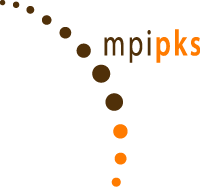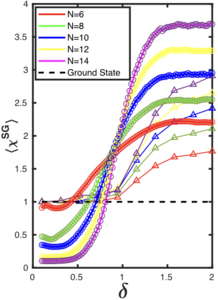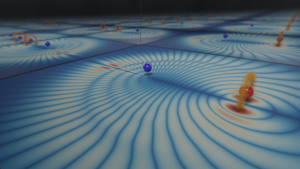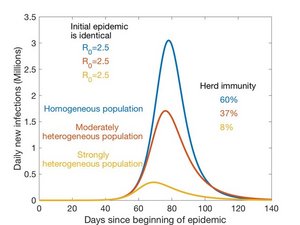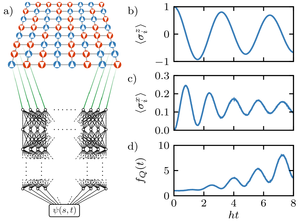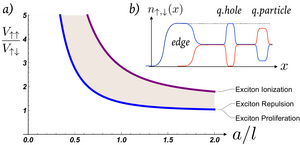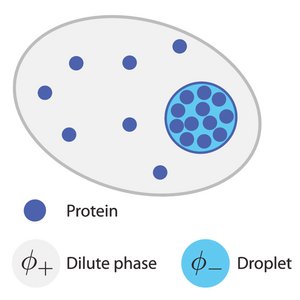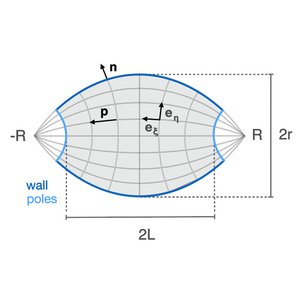
Archived Publication Highlights
Publication Highlights
Many-Body Delocalization via Emergent Symmetry
Many-body localization (MBL) provides a mechanism to avoid thermalization in many-body quantum systems. Here, we show that an emergent symmetry can protect a state from MBL. Specifically, we propose a $Z_2$ symmetric model with nonlocal interactions, which has an analytically known, SU(2) invariant, critical ground state. At large disorder strength, all states at finite energy density are in a glassy MBL phase, while the lowest energy states are not. These do, however, localize when a perturbation destroys the emergent SU(2) symmetry. The model also provides an example of MBL in the presence of nonlocal, disordered interactions that are more structured than a power law. Finally, we show how the protected state can be moved into the bulk of the spectrum.
N. S. Srivatsa et al., Phys. Rev. Lett. 125, 240401 (2020).
weiterlesenN. S. Srivatsa et al., Phys. Rev. Lett. 125, 240401 (2020).
Publication Highlights
Protein condensates as aging Maxwell fluids
Cells organize their biochemistry by forming liquid-like condensates of biomolecules that can act as tiny reactors to localize chemical reactions. Researchers from the Physics of Complex Systems together with with colleagues of the MPI of molecular cell biology and genetics in Dresden investigate the physical nature and material properties of protein condensates using microrheology techniques. They find that many protein condensates increase their viscosity with time and slow their dynamics, while always remaining soft and liquid-like. This is suggestive of glassy behaviors and could have important implications for cellular dynamics.
Jawerth et al. Science 370, 1317 (2020)
weiterlesenJawerth et al. Science 370, 1317 (2020)
Publication Highlights
The surprising mise en abyme of a Rydberg molecule
We predict a new class of Rydberg molecules, comprised of a Rydberg atom and a ground state atom, whose energy spectrum conforms to a certain mise en abyme: nested within successive levels of the infinite electronic Rydberg series lie several finite vibrational Rydberg series. These intertwined series arise from Coulomb potentials in the electronic and nuclear degrees of freedom. The emergence of nuclear Coulomb interaction in a Rydberg molecule is surprising because it is otherwise found only in a heavy Bohr atom, consisting of a cation and an anion. We establish a connection between heavy Bohr atoms and Rydberg molecules via a dressed ion-pair model. In this new perspective, the low-energy scattering of the Rydberg electron off of the ground state atom dresses the neutral atom with a fractional negative charge. Coulomb forces between this dressed anion and the Rydberg cation lead to the formation of Rydberg molecules. In the class of Rydberg molecules we predict, this charge is nearly independent of the internuclear distance, yielding a Coulombic potential. Although this property and the effective ion-pair binding mechanism are very unusual, these molecules need not be: our work shows that these are generic, and can be formed from a Rydberg atom and any neutral polarizable object.
P. Giannakeas et al., Phys. Rev. Lett. 125, 123401 (2020)
weiterlesenP. Giannakeas et al., Phys. Rev. Lett. 125, 123401 (2020)
Publication Highlights
Power-law population heterogeneity governs epidemic waves
Differences between individuals reduce the number of infections required for herd immunity
In rapidly spreading epidemics such as the current coronavirus pandemic, it is usually expected that a majority of the population will be infected before herd immunity is achieved and the epidemic abates. The estimate of when the threshold for this is reached is usually based on models that assume all individuals in a population are identical. Researchers at the Max Planck Institute for the Physics of Complex Systems in Dresden have used a new model to demonstrate that herd immunity can be achieved at a lower threshold if some individuals are more easily infected than others.
J. Neipel et al., PLoS ONE 15(10): e0239678 (2020).
weiterlesenIn rapidly spreading epidemics such as the current coronavirus pandemic, it is usually expected that a majority of the population will be infected before herd immunity is achieved and the epidemic abates. The estimate of when the threshold for this is reached is usually based on models that assume all individuals in a population are identical. Researchers at the Max Planck Institute for the Physics of Complex Systems in Dresden have used a new model to demonstrate that herd immunity can be achieved at a lower threshold if some individuals are more easily infected than others.
J. Neipel et al., PLoS ONE 15(10): e0239678 (2020).
Publication Highlights
Interaction-Induced Transparency for Strong-Coupling Polaritons
The propagation of light in strongly coupled atomic media takes place through the formation of polaritons—hybrid quasiparticles resulting from a superposition of an atomic and a photonic excitation. Here we consider the propagation under the condition of electromagnetically induced transparency and show that a novel many-body phenomenon can appear due to strong, dissipative interactions between the polaritons. Upon increasing the photon-pump strength, we find a first-order transition between an opaque phase with strongly broadened polaritons and a transparent phase where a long-lived polariton branch with highly tunable occupation emerges. Across this nonequilibrium phase transition, the transparency window is reconstructed via nonlinear interference effects induced by the dissipative polariton interactions. Our predictions are based on a systematic diagrammatic expansion of the nonequilibrium Dyson equations which can be controlled, even in the nonperturbative regime of large single-atom cooperativities, provided the polariton interactions are sufficiently long-ranged. Such a regime can be reached in photonic crystal waveguides thanks to the tunability of interactions, allowing us to observe the interaction-induced transparency transition even at low polariton densities.
J. Lang et al., Phys. Rev. Lett. 125, 133604 (2020)
weiterlesenJ. Lang et al., Phys. Rev. Lett. 125, 133604 (2020)
Publication Highlights
Quantum many-body dynamics in two dimensions with artificial neural networks
In the last two decades the field of nonequilibrium quantum many-body systems has seen a rapid development driven, in particular, by the remarkable progress in quantum simulators, which provide access to dynamics in quantum matter with an unprecedented control. However, the efficient numerical simulation of nonequilibrium real-time evolution in isolated quantum matter remains a key challenge for current computational methods especially beyond one spatial dimension. In this work we present a versatile and efficient machine learning inspired approach based on a recently introduced artificial neural network encoding of quantum many-body wave functions. We identify and resolve key challenges for the simulation of real-time evolution, which previously imposed significant limitations on the accurate description of large systems and long-time dynamics. As a concrete example, we study the dynamics of the paradigmatic two-dimensional transverse field Ising model, where we observe collapse and revival oscillations of ferromagnetic order and demonstrate that the reached time scales are comparable to or exceed the capabilities of state-of-the-art tensor network methods.
M. Schmitt and M. Heyl, Phys. Rev. Lett. 125, 100503 (2020)
weiterlesenM. Schmitt and M. Heyl, Phys. Rev. Lett. 125, 100503 (2020)
Publication Highlights
Realization of an anomalous Floquet topological system with ultracold atoms
Coherent control via periodic modulation, also known as Floquet engineering, has emerged as a powerful experimental method for the realization of novel quantum systems with exotic properties. In particular, it has been employed to study topological phenomena in a variety of different platforms. In driven systems, the topological properties of the quasienergy bands can often be determined by standard topological invariants, such as Chern numbers, which are commonly used in static systems. However, due to the periodic nature of the quasienergy spectrum, this topological description is incomplete and new invariants are required to fully capture the topological properties of these driven settings. Most prominently, there are two-dimensional anomalous Floquet systems that exhibit robust chiral edge modes, despite all Chern numbers being equal to zero. Here we realize such a system with bosonic atoms in a periodically driven honeycomb lattice and infer the complete set of topological invariants from energy gap measurements and local Hall deflections.
Wintersperger et al., Nature Physics (2020)
weiterlesenWintersperger et al., Nature Physics (2020)
Publication Highlights
Excitonic Laughlin states in ideal topological insulator flat bands and their possible presence in moiré superlattice materials
We investigate few- and many-body states in half-filled ideal topological insulator flat bands realized by two degenerate Landau levels which experience opposite magnetic fields. This serves as a toy model of flat bands in moiré materials in which valleys have Chern numbers $C=\pm 1$. We argue that although the spontaneously polarized Ising Chern magnet is a natural ground state for repulsive Coulomb interactions, it can be in reasonable energetic competition with correlated Laughlin states of excitons when short-distance corrections to interactions are included. This is because charge neutral excitons in these bands behave effectively as charged particles in ordinary Landau levels. In particular, the Ising Chern magnet is no longer the ground state once the strength of a short-range intravalley repulsion is about 30% larger than the intervalley repulsion. Remarkably, these excitonic Laughlin states feature valley number fractionalization but no charge fractionalization and a quantized charge Hall conductivity identical to the Ising magnet, $\sigma_{xy}=±e2/h$, and thus cannot be distinguished from it by ordinary charge transport measurements. The Laughlin state with the highest density of excitons that can be constructed in these bands is an analog of $\nu=1/4$ bosonic Laughlin state and has no valley polarization even though it spontaneously breaks time reversal symmetry.
N. Stefanidis and I. Sodemann, Phys. Rev. B 102, 035158 (2020)
weiterlesenN. Stefanidis and I. Sodemann, Phys. Rev. B 102, 035158 (2020)
Publication Highlights
Phase separation provides a mechanism to reduce noise in cells
Expression of proteins inside cells is noisy, causing variability in protein concentration among identical cells. A central problem in cellular control is how cells cope with this inherent noise. Compartmentalization of proteins through phase separation has been suggested as a potential mechanism to reduce noise, but systematic studies to support this idea have been missing. In this study, we used a physical model that links noise in protein concentration to theory of phase separation to show that liquid droplets can effectively reduce noise. We provide experimental support for noise reduction by phase separation using engineered proteins that form liquid-like compartments in mammalian cells. Thus, phase separation can play an important role in biological signal processing and control.
Klosin et al., Science 366, 464 (2020)
weiterlesenKlosin et al., Science 366, 464 (2020)
Publication Highlights
Active Forces Shape the Metaphase Spindle through a Mechanical Instability
The metaphase spindle is a dynamic structure orchestrating chromosome segregation during cell division. Recently, soft matter approaches have shown that the spindle behaves as an active liquid crystal. Still, it remains unclear how active force generation contributes to its characteristic spindle-like shape. Here we combine theory and experiments to show that molecular motor-driven forces shape the structure through a barreling-type instability. We test our physical model by titrating dynein activity in Xenopusegg extract spindles and quantifying the shape and microtubule orientation. We conclude that spindles are shaped by the interplay between surface tension, nematic elasticity, and motor-driven active forces. Our study reveals how motor proteins can mold liquid crystalline droplets and has implications for the design of active soft materials.
Oriola et al., PNAS (2020)
weiterlesenOriola et al., PNAS (2020)
